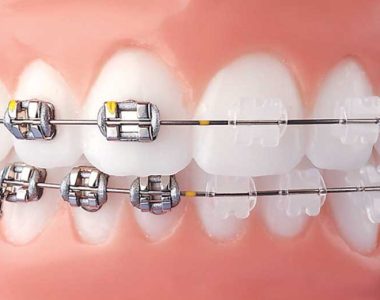

Braces can correct a wide range of dental issues, including crooked, gapped, rotated or crowded teeth. There are several types of braces, including traditional metal braces, ceramic braces and clear aligners like Invisalign®. Braces improve your smile’s health, function and appearance and thus improves your confidence.
Teeth Braces
Overview
What are braces?
Dental braces straighten your teeth and correct a wide range of orthodontic issues, such as:
- Crooked teeth.
- Crowded teeth.
- Gapped teeth.
- Malocclusion (issues with the way your teeth fit together).
Many children and teens wear braces, but adult braces are common, too. In fact, about 20% of all orthodontic patients in the United States are over the age of 18.
In most cases, orthodontists place braces. But some general dentists offer them too.
How do braces work?
Braces use mild, constant pressure to shift your teeth into their proper positions over time. The exact way this happens depends on the type of braces you choose.
There are several different types of braces. The type that’s best for you depends on a few factors, including the kind of issue you have, the severity of your condition and your personal preferences.

What are the types of braces?
Metal braces
When you think of braces, traditional metal braces might be what you imagine. Metal braces use stainless steel bands, brackets and wires to gently shift your teeth over time.
A dentist or orthodontist will bond (glue) a bracket on each tooth, then place a thin, flexible archwire over the brackets. Tiny elastic bands called ligatures keep the wire firmly in place.
Metal braces are visible when you smile. You can choose clear or tooth-colored ligatures to make your braces less noticeable. Or, if you’re feeling festive, you can choose brightly colored ligatures.
Ceramic braces
Ceramic braces — sometimes called clear braces — work the same way as metal braces. The key difference is that the brackets, wires and ligatures are tooth-colored, so they blend in with your smile. Ceramic braces are still visible, but they’re less noticeable. One drawback to ceramic braces is that they’re more fragile than metal braces, so they’re more likely to break.
Lingual braces
Lingual braces are similar to traditional braces. But they go on the back surfaces of your teeth instead of the front. Most people who choose lingual braces do so because they don’t want other people to be able to tell they have braces.
Self-ligating braces
Self-ligating braces look similar to traditional metal braces. The main difference is that, instead of ligatures (tiny elastic bands), self-ligating braces use a built-in system to hold the archwire in place.
Clear aligners
Sometimes called “invisible braces,” clear aligners are a braces alternative. Instead of brackets and wires, clear aligners use a series of custom-made trays to straighten your teeth over time. Popular brands include Invisalign® and ClearCorrect®.
With these systems, you wear each set of aligner trays for approximately two weeks. Then, you swap those trays out for the next set in the series. Unlike metal braces, clear aligners are removable. But you have to wear them for at least 22 hours every day. You should only take your aligners out to eat, drink and brush your teeth.
What age is best for braces?
You’re never too old for orthodontics. That said, the best time for braces is generally between the ages of 9 and 14. At this point, your jaws and facial bones are more malleable (flexible) because they’re still developing. Adult braces are just as effective, but it might take a little longer to achieve the desired results.
Procedure Details
How long do braces take to work?
The answer to this question is different for everyone. On average, braces treatment takes about two years to complete. But it depends on the severity of misalignment. Some people finish treatment in under 12 months. Others may need as long as three years.
Risks / Benefits
What are the benefits of dental braces?
The most obvious advantage of braces is a straighter, more beautiful smile. But braces can also:
- Make your teeth easier to clean.
- Help prevent cavities and gum disease.
- Correct temporomandibular joint (TMJ) disorders.
- Restore proper functions like chewing and speaking.
In short, braces can improve the health, function and appearance of your smile.
What are the normal side effects of braces?
There are some mild, expected side effects of braces, including:
- Temporary discomfort (which usually occurs the first day and any time your dentist tightens your braces).
- Irritation on your tongue, lips or inner cheeks.
- Jaw pain.
- Difficulty eating (especially after a tightening).
You can manage most of these side effects with over-the-counter (OTC) pain relievers. You can also purchase dental wax for braces at your local pharmacy to help with irritation inside your mouth. Simply place some wax over any rough-feeling brackets or wire.
Recovery and Outlook
Do braces hurt?
You’ll likely have discomfort for a few days after you get your braces. Some people experience tenderness after routine tightening, too. But generally, your braces shouldn’t hurt.
To ease discomfort after your orthodontic appointments, you can take acetaminophen (Tylenol®). It’s best to avoid ibuprofen (Advil®) and other nonsteroidal anti-inflammatory drugs (NSAIDs). Research shows that NSAIDs block prostaglandins — hormone-like substances that help with healing. As a result, NSAIDs can actually interrupt the tooth movement process.
How should I care for my braces?
Proper oral hygiene is even more important when you wear braces. Plaque and tartar can build up around your brackets and wires, leading to cavities and gingivitis.
Your dentist or orthodontist will give you a detailed list of instructions for taking care of your braces. But here are a few general guidelines:
- Brush your teeth at least twice a day using a soft-bristled toothbrush and fluoride toothpaste.
- Floss between your teeth and around your braces once a day. (Ask your dentist or orthodontist about special floss for braces.)
- If you have clear aligners, clean them every day and store them properly when you’re not wearing them.
- Swish with an alcohol-free, antibacterial mouthwash twice a day.
- Avoid hard, crunchy or sticky foods.
- Visit your orthodontist regularly for tightening and maintenance.
- Visit your dentist regularly for cleanings and routine dental care.
What can you eat with braces?
After you get your braces, you’ll want to stick to soft foods for a few days. Good options include:
- Pasta.
- Cooked vegetables.
- Mashed potatoes.
- Scrambled eggs.
- Yogurt.
- Soup.
- Soft fruits.
- Oatmeal
- Khichdi
- Daal rice
- Curd rice
Once the discomfort wears off, you can start adding other foods to your diet.
You should avoid certain hard and sticky foods the entire time you have braces. This includes nuts, caramels and crunchy fruits and veggies.
How can I maintain my results after braces?
Anyone who wears braces will need to wear a teeth retainer when they’re done with treatment. A retainer prevents your teeth from shifting back into their old positions.
There are many types of retainers. Your dentist or orthodontist will help choose one that’s right for you.
When to Call the Doctor
When should I call my dentist or orthodontist?
Call your healthcare provider if you have:
- Pain that doesn’t go away with medication.
- Broken wires or brackets.
- Trauma to your mouth or face.
- Bleeding or infection in your gums.
Frequently Asked Questions
Invisalign vs. braces: Which option is right for me?
This is something only your dentist or orthodontist can tell you. But generally, Invisalign can correct most mild to moderate orthodontic issues. If your case is severe, traditional braces might be more suitable.
Can I buy special floss for braces?
Yes, there are several products on the market that make flossing with braces easier, including:
- Floss threaders.
- Dental picks.
- Orthodontic flossers.
- Interproximal brushes (tiny brushes that fit between your teeth).
- Water flossers.
Ask your dentist or orthodontist for product recommendations.
Can you chew gum with braces?
Yes, you can chew sugarless gum. Be sure to shop for brands that have the ADA Seal of Acceptance.
A note from Dental Essence
Teeth braces not only enhance your smile, but they also improve oral health and function. Today, there are many orthodontic options available. Your dentist or orthodontist can help determine the one that works best for you. Braces are an investment that can give you a healthy, beautiful smile for years to come.

Dr. Prachi Bafna
“Braces can have a life changing effect on your personality and confidence. Be it gaps in teeth, crooked teeth, bunny teeth, gummy smile, inconspicuous teeth, it can all be correct by braces.”

Your First Visit
*Full exam, cleaning, and x-rays
*Time to meet your dentist and ask questions
*Custom treatment plan designed just for you
*Discussion of finances and insurance options
See us once and you’ll become a patient for life. There’s no other dentist in Pune quite like us. At your first appointment, expect to spend about 90 minutes with us for examination & get-to-know-you time with your dentist.
ON TIME
We know how busy your schedule is, so your appointment will always start on time with no waiting. We work on appointment basis.
HASSLE-FREE
The entire process from scheduling your appointment to billing is hassle-free. All modes of payment are available.
HI-TECH
You may not get as excited as we do about our machines, but you’ll smile when you see how great you look and feel.


dr.bafnaprachi@gmail.com
PHONE NUMBER
9588695155
020-27293429
timings
Mon-Sat: 10am-9pm
Sun: By Appointment`
ADDRESS
203, Fortune House,
Baner-Pashan Link Road
Pune-411021
